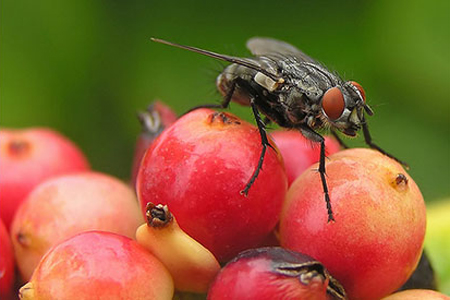When Temperatures Rise, Evolution Can Come To The Rescue

(ISNS) -- For some creatures, climate change would simply be a walk in the genetic park.
Among them are fruit flies, many scientists’ favorite insects. Researchers at the Universitat Autònoma de Barcelona in Spain have found that the flies react to a heat wave by evolving to be more heat tolerant in a blazingly short time. When the heat wave cools down, the species simply evolves back.
On April 1, 2011, unusually warm air from Africa pushed into the Iberian Peninsula and much of Western Europe. The heat wave peaked in Spain about a week later and produced some of the highest April temperatures ever recorded in Spain and England.
The heat wave turned out to be an ideal time to see how the flies coped with the sudden change. The scientists collected flies from two areas, far enough from each other to guarantee the flies were not genetically identical.
For decades, they studied a species of fruit fly, Drosophila subobscura, which is common in Europe and North America, said Francisco José Rodriguez-Trelles Astruga, the principal investigator. They generally went out in the field four times a year with nets, once for each season, catching wild flies.
Rodriguez-Trelles said each trip they collect 100-150 male flies, which then breed in the lab with flies with a different, known genome.
Biologists love fruit flies, and have been studying them since the early part of the 20th century. The flies have either four or five chromosomes, depending on species, and the genetic makeup is well-known and easy to study. They are ideal models for genetic studies and teaching.
Sign up for the Live Science daily newsletter now
Get the world’s most fascinating discoveries delivered straight to your inbox.
“Their short life cycle would mean selection is quite rapid,” said Peter Lawrence, emeritus scientist at the University of Cambridge. Insects are extremely sensitive to climate changes. For fruit flies, Lawrence said, they become sterile if the temperature drops too far.
The species of fruit fly studied in the Spanish experiment was not the one usually used in biology laboratories, he said, although it was not clear to him if that would change the results.
Three weeks after the start of the heat wave, the Spanish scientists began collecting samples of the subobscura, usually waiting until between mid-afternoon and sunset, when temperatures were at their highest.
Back in the lab, they analyzed the genome of the samples and matched them with temperature data on the heat wave, provided by the Spanish National Agency of Meteorology.
The Barcelona scientists were studying a particular type of genetic mutation called an inversion, where some genes in a chromosome flip to the opposite order. For example, if a line of genes read ABCDEFGHIJKLMN, an inversion of the segment DEFGH would read ABCHGFEDIJKLMN. Inversions prevent random recombination of genes, a mutation sometimes called jumping genes.
The genome of the flies had inversions that made them more resistant to heat and inversions that did the opposite, making it easier to monitor the changes as generations went by, the scientists theorized. They found the increased temperatures directly affected which inversions kicked in, and the hotter it got, the greater the change. When the weather cooled down, the reverse was true, depending on which inversion was dominant.
“What changes,” Rodriguez-Trelles said, “is their relative frequency as a result of natural selection. … The effect of the heat wave was a dramatic increase in the relative frequency of the heat-adapted variance.”
The discovery does not necessarily mean the Drosophila will be immune to global warming, Rodriguez-Trelles said. The collection took place in the spring when the temperatures were still milder than they would have been during a mid-summer heat wave.
Nonetheless, he said, the flies captured for this experiment are more heat-tolerant than flies captured in the mid-1970s, showing they were already adapting to climate change.
“This is the first study, to our knowledge, that provides unequivocal evidence that natural populations are genetically responding ... to higher temperatures alone,” the scientists wrote in the journal Biology Letters. The change occurred not only in one site on the genome, they wrote, but at various locations and again in direct relation with the temperatures.
Inside Science News Service is supported by the American Institute of Physics. Joel Shurkin is a freelance writer based in Baltimore. He is the author of nine books on science and the history of science, and has taught science journalism at Stanford University, UC Santa Cruz and the University of Alaska Fairbanks.










